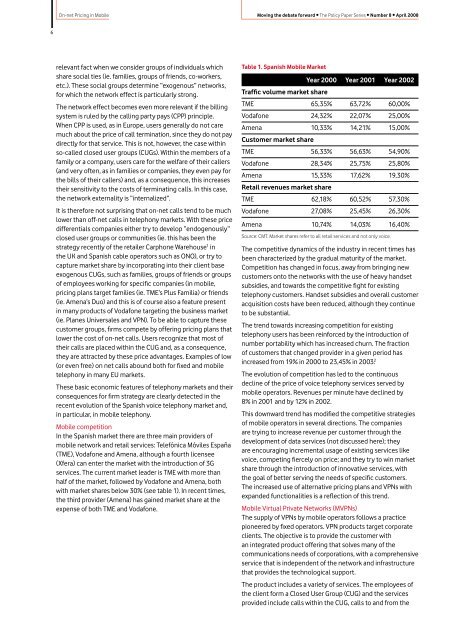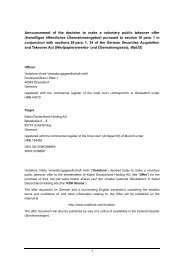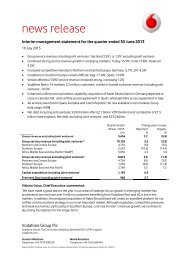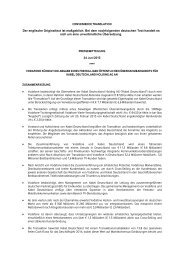Create successful ePaper yourself
Turn your PDF publications into a flip-book with our unique Google optimized e-Paper software.
6<br />
On-net Pricing in Mobile Moving the debate forward • The Policy Paper Series • Number 8 • April 2008<br />
relevant fact when we consider groups of individuals which<br />
share social ties (ie. families, groups of friends, co-workers,<br />
etc.). These social groups determine “exogenous” networks,<br />
for which the network effect is particularly strong.<br />
The network effect becomes even more relevant if the billing<br />
system is ruled by the calling party pays (CPP) principle.<br />
When CPP is used, as in Europe, users generally do not care<br />
much about the price of call termination, since they do not pay<br />
directly for that service. This is not, however, the case within<br />
so-called closed user groups (CUGs). Within the members of a<br />
family or a company, users care for the welfare of their callers<br />
(and very often, as in families or companies, they even pay for<br />
the bills of their callers) and, as a consequence, this increases<br />
their sensitivity to the costs of terminating calls. In this case,<br />
the network externality is “internalized”.<br />
It is therefore not surprising that on-net calls tend to be much<br />
lower than off-net calls in telephony markets. With these price<br />
differentials companies either try to develop “endogenously”<br />
closed user groups or communities (ie. this has been the<br />
strategy recently of the retailer Carphone Warehouse1 in<br />
the UK and Spanish cable operators such as ONO), or try to<br />
capture market share by incorporating into their client base<br />
exogenous CUGs, such as families, groups of friends or groups<br />
of employees working for specific companies (in mobile,<br />
pricing plans target families (ie. TME’s Plus Familia) or friends<br />
(ie. Amena’s Duo) and this is of course also a feature present<br />
in many products of <strong>Vodafone</strong> targeting the business market<br />
(ie. Planes Universales and VPN). To be able to capture these<br />
customer groups, firms compete by offering pricing plans that<br />
lower the cost of on-net calls. Users recognize that most of<br />
their calls are placed within the CUG and, as a consequence,<br />
they are attracted by these price advantages. Examples of low<br />
(or even free) on net calls abound both for fixed and mobile<br />
telephony in many EU markets.<br />
These basic economic features of telephony markets and their<br />
consequences for firm strategy are clearly detected in the<br />
recent evolution of the Spanish voice telephony market and,<br />
in particular, in mobile telephony.<br />
Mobile competition<br />
In the Spanish market there are three main providers of<br />
mobile network and retail services: Telefónica Móviles España<br />
(TME), <strong>Vodafone</strong> and Amena, although a fourth licensee<br />
(Xfera) can enter the market with the introduction of 3G<br />
services. The current market leader is TME with more than<br />
half of the market, followed by <strong>Vodafone</strong> and Amena, both<br />
with market shares below 30% (see table 1). In recent times,<br />
the third provider (Amena) has gained market share at the<br />
expense of both TME and <strong>Vodafone</strong>.<br />
Table 1. Spanish Mobile Market<br />
Year 2000<br />
Traffic volume market share<br />
Year 2001 Year 2002<br />
TME 65,35% 63,72% 60,00%<br />
<strong>Vodafone</strong> 24,32% 22,07% 25,00%<br />
Amena 10,33% 14,21% 15,00%<br />
Customer market share<br />
TME 56,33% 56,63% 54,90%<br />
<strong>Vodafone</strong> 28,34% 25,75% 25,80%<br />
Amena 15,33% 17,62% 19,30%<br />
Retail revenues market share<br />
TME 62,18% 60,52% 57,30%<br />
<strong>Vodafone</strong> 27,08% 25,45% 26,30%<br />
Amena 10,74% 14,03% 16,40%<br />
Source: CMT. Market shares refer to all retail services and not only voice.<br />
The competitive dynamics of the industry in recent times has<br />
been characterized by the gradual maturity of the market.<br />
Competition has changed in focus, away from bringing new<br />
customers onto the networks with the use of heavy handset<br />
subsidies, and towards the competitive fight for existing<br />
telephony customers. Handset subsidies and overall customer<br />
acquisition costs have been reduced, although they continue<br />
to be substantial.<br />
The trend towards increasing competition for existing<br />
telephony users has been reinforced by the introduction of<br />
number portability which has increased churn. The fraction<br />
of customers that changed provider in a given period has<br />
increased from 19% in 2000 to 23,45% in 2003. 2<br />
The evolution of competition has led to the continuous<br />
decline of the price of voice telephony services served by<br />
mobile operators. Revenues per minute have declined by<br />
8% in 2001 and by 12% in 2002.<br />
This downward trend has modified the competitive strategies<br />
of mobile operators in several directions. The companies<br />
are trying to increase revenue per customer through the<br />
development of data services (not discussed here); they<br />
are encouraging incremental usage of existing services like<br />
voice, competing fiercely on price; and they try to win market<br />
share through the introduction of innovative services, with<br />
the goal of better serving the needs of specific customers.<br />
The increased use of alternative pricing plans and VPNs with<br />
expanded functionalities is a reflection of this trend.<br />
Mobile Virtual Private Networks (MVPNs)<br />
The supply of VPNs by mobile operators follows a practice<br />
pioneered by fixed operators. VPN products target corporate<br />
clients. The objective is to provide the customer with<br />
an integrated product offering that solves many of the<br />
communications needs of corporations, with a comprehensive<br />
service that is independent of the network and infrastructure<br />
that provides the technological support.<br />
The product includes a variety of services. The employees of<br />
the client form a Closed User Group (CUG) and the services<br />
provided include calls within the CUG, calls to and from the

















